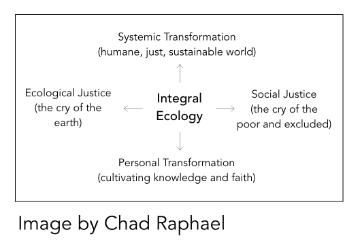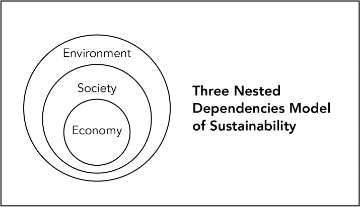Leading Through Laudato Si' Operational Definitions
This list defines some key terms used in Leading Through Laudato Si'. These are not meant to be universal definitions, but instead provide a sense of the frameworks used to develop and write the plan.
Carbon pollution
Human activities are responsible for almost all of the increase in greenhouse gases (such as carbon dioxide) in the atmosphere over the last 150 years thanks in large part to burning fossil fuels for electricity, heat, and transportation. (IPCC (2013) qtd. in U.S. EPA) People of lower incomes “and some racial and ethnic groups are among those who often face higher exposure to pollutants [from greenhouse gases] and who may experience greater responses to such pollution.” (American Lung Association)
Climate positive
“Going beyond achieving climate neutrality to create an environmental benefit by removing additional GHG emissions from the atmosphere.” (Plan A Earth)
Common good
“The sum of those conditions of social life which allow social groups and their individual members relatively thorough and ready access to their own fulfilment.” (Gaudium et Spes qtd. in Laudato Si’ paragraph 156)
Common home
Term in the subtitle of Laudato Si’ that emphasizes the necessity of viewing our planet as a unified homeland: “humanity is one people living in a common home. An interdependent world not only makes us more conscious of the negative effects of certain lifestyles and models of production and consumption which affect us all; more importantly, it motivates us to ensure that solutions are proposed from a global perspective, and not simply to defend the interests of a few countries. Interdependence obliges us to think of one world with a common plan.” (paragraph 164)
Environmental justice
A concept and movement that affirms the right of people of color and of low income, Indigenous peoples, women, other marginalized communities, future generations, and all species to thrive, rather than having their lands, homes, cultures, and lives poisoned or stolen. Includes efforts to reduce environmental burdens and increase benefits for communities and the earth; prioritize the meaningful participation of community members in decision-making; value diverse cultures, knowledges, and perspectives; and transform systems to create just and reciprocal relations. (Ground Truths: Community-Engaged Research for Environmental Justice, Chad Raphael and Martha Matsuoka)
ESG
Acronym for Environmental, Social, Governance. ESG investing is an approach to investing “that selects companies based on their stated commitment to one or more ESG factors – for example, companies with policies aimed at minimizing their negative impact on the environment or companies that focus on governance principles and transparency.” (U.S. SEC)
Integral ecology

Building on previous church teachings (St. John Paul II’s “human ecology” and Pope Benedict XVI’s “ecology of man”), Pope Francis’ term “integral ecology” “highlights not just the interconnectedness that exists among God, humanity and creation, but also recognizes how political, economic, cultural, social, and religious values and decisions are interrelated and affect the way people live with one another on the planet and use its resources.” (Catholic News Service) Pope Francis offers this direct approach in Laudato Si’ “Strategies for a solution demand an integrated approach to combating poverty, restoring dignity to the excluded, and at the same time protecting nature.” (paragraph 139)
JEDI
Acronym for Justice (dismantling barriers to resources and opportunities in society so that all individuals and communities can live a full and dignified life), Equity (allocating resources to ensure everyone has access to the same resources and opportunities), Diversity (all the differences between us that determine which advantages or barriers we encounter in our lived experience), and Inclusion (fostering a sense of belonging by centering, valuing, and amplifying the voices, perspectives and styles of those who experience more barriers based on their identities). (SCU JEDI Strategic Plan)
Just sustainability
“The need to ensure a better quality of life for all, now and into the future, in a just and equitable manner, whilst living within the limits of supporting ecosystems” (Agyeman, Bullard, and Evans, MIT Press)
Laudate Deum
In October 2023, Pope Francis released this follow-up exhortation to Laudato Si’ which “emphasizes the severity and depth of our climate crisis, and the need for immediate and bold action to care for our common home” both now and in the future. (Catholic Climate Covenant)
Laudato Si’: On Care for Our Common Home
In May 2015, Pope Francis released his landmark encyclical which focuses on caring for the natural environment and all people, as well as broader questions about the “relationship between God, humans, and the Earth.” (laudatosimovement.org)
Reconciliation
Encompasses truth-telling, sharing of historical narratives, or dialogue to transform relations among groups affected by conflict and rebuild trust between the state and citizens so that former enemies can envision and realize a shared future. (U.S. Institute of Peace)
Sustainability

The interdependence and interconnectedness of ecological, social, and economic systems. “AASHE defines sustainability in a pluralistic and inclusive way, encompassing human and ecological health, social justice, secure livelihoods, and a better world for all generations.” (AASHE)
Underrepresented groups
Social groups that have historically been denied access or suffered institutional discrimination and/or are currently underrepresented or disadvantaged relative to one or more dominant groups. Individuals from underrepresented groups may include, but are not limited to: ethnic, national, religious, and linguistic minorities; incarcerated and formerly incarcerated individuals; indigenous peoples; LGBTQ+ individuals; migrants, refugees, and asylum seekers; people with disabilities; racialized people; residents of economically divested areas; Roma, Sinti, and Travelers; survivors and veterans of conflict; and women. (adapted from “historically underrepresented” at Boston Medical Center)